NCERT Solutions for Class 10 Science Chapter 11: Intext and exercise questions help students to practice and learn. They help students to understand how much they have actually understood from what they have learnt. It is important that students are aware of the accurate answers to the questions. In this article we have covered the detailed answers for NCERT Class 10 Science Chapter 11 Electricity.
NCERT Books help students to gain an understanding of concepts and strengthen their basics. They are published based on the latest CBSE syllabus. These books are recommended due to their explanation of even difficult topics in simple and clear language.
Also Check: Difference Between Pound and Kilogram: Major Differences Between The Units
Questions given in the NCERT books are always considered very important as not only do they help you to analyse your understanding of the concepts involved in a chapter but also in preparing for the examinations. Students should read the chapters carefully along with attempting the questions given.
In this article students can get the NCERT Solutions for Class 10 Science Chapter 11. Students can download the NCERT Solutions for Class 10 Electricity in pdf format.
NCERT Class 10 Science Electricity Solutions
Check all the questions and answers of NCERT Class 10 Chapter 11 Electricity. Go through the solutions for the exercise and intext questions.
Intext Questions and Solutions Page no. 172
Q. What does an electric circuit mean?
Sol. An electric circuit consists of electric devices, switching devices, etc. These things are connected by conducting wires.
Q. Define the unit of current.
Sol. The unit of electric current is ampere (A). 1 A is defined as the flow of 1 C of charge through a wire in 1 s.
Q. Calculate the number of electrons constituting one coulomb of charge.
Sol. 1e=1.6×10−19C
∴1 C of charge is contained in 1/1.6x 10(-19)=6.25x10(18) electrons
Intext Questions and Solutions Page no. 174
Q. Name a device that helps to maintain a potential difference across a conductor.
Sol. It can be any source of electricity like cell, battery, etc that helps to maintain a potential difference across a conductor.
Q. What is meant by saying that the potential difference between two points is 1 V?
Sol. If 1J of work is required to move a charge of amount 1C from one point to another, then it is said that the potential difference between the two points is 1V.
Q. How much energy is given to each coulomb of charge passing through a 6 V battery?
Sol. The energy given to each coulomb of charge is equal to the amount of work required to move it.
The amount of work is:
V=w/q
w=V×q
Where, q=I C
Potential difference= 6 V, w=6J
Intext Questions and Solutions Page no. 181
Q. On what factors does the resistance of a conductor depend?
Sol. The resistance of a conductor depends upon the following factors:
Length of the conductor
Cross-sectional area of the conductor
Material of the conductor
Temperature of the conductor
Q. Will current flow more easily through a thick wire or a thin wire of the same material, when connected to the same source? Why?
Sol. Resistance of a wire, R = ρ l/A
where,
ρ= Resistivity of the material of the wire
l=Length of the wire
A=Area of cross-section of the wire
Resistance is inversely proportional to the area of cross-section of the wire. Thicker the wire, lower is the resistance of the wire and vice versa. Therefore, current can flow more easily through a thick wire than a thin wire.
Q. Let the resistance of an electrical component remain constant while the potential difference across the two ends of the component decreases to half of its former value. What change will occur in the current through it?
Sol. Given that resistance R of the electrical component remains constant but the potential difference across the ends of the component decreases to half of its value. Therefore, the amount of current flowing through the electrical component is reduced by half.
Q. Why are coils of electric toasters and electric irons made of an alloy rather than a pure metal?
Sol. Alloys are used for making coils of electric toasters and electric irons as melting point of alloys are higher and they do not melt easily.
Q. Use the data in Table 11.2 to answer the following –
(a) Which among iron and mercury is a better conductor? (b) Which material is the best conductor?
Sol. (a)Iron is a better conductor than mercury.
(b)Resistivity of silver is the lowest among the listed materials. Hence, it is the best conductor.
Intext Questions and Solutions Page no. 185
Q. Draw a schematic diagram of a circuit consisting of a battery of three cells of 2 V each, a 5 Ω resistor, an 8 Ω resistor, and a 12 Ω resistor, and a plug key, all connected in series.
Sol. 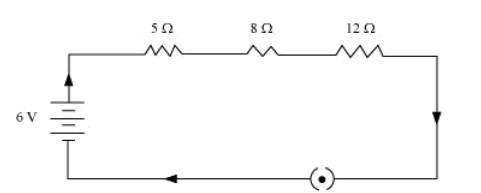
Q. Redraw the circuit of Question 1, putting in an ammeter to measure the current through the resistors and a voltmeter to measure the potential difference across the 12 Ω resistor. What would be the readings in the ammeter and the voltmeter?
Sol. 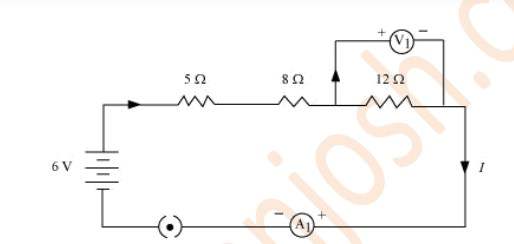
The resistances are connected in series.
Ohm’s law can be used to obtain the readings of ammeter and voltmeter.
According to Ohm’s law,
V=IR,
Potential difference, V=6V
Resistance of the circuit, R is:
R=5+8+12=25Ω
I = V/R = 6/25 = 0.24A
Potential difference across 12 Ω resistor= V1
Current flowing through the 12 Ω resistor, I=0.24 A
Therefore, using Ohm’s law, we obtain
V1 =IR=0.24×12=2.88V
Hence, the reading of the ammeter will be 0.24 A. The reading of the voltmeter is 2.88 V.
Intext Questions and Solutions Page no. 188
Q. Judge the equivalent resistance when the following are connected in parallel –
(a) 1 Ω and 10(6) Ω, (b) 1 Ω and 10(3) Ω, and 10(6) Ω.
Sol. (a) When 1 Ω and 10(6) Ω are connected in parallel:
Let R be the equivalent resistance.
1/R = 1/R1 + 1/R2 + 1/R3
1/R = 1/1+ 1/106 = 1+ 10-6
R = 1 Ω
Therefore, equivalent resistance=1Ω
(b) When resistances are connected in parallel:
Let R be the equivalent resistance.
I/R=1+1/10(3)+1/10(6)
1/R=1+10(6)+10(3)/10(6)
R=0.999Ω
Therefore, equivalent resistance=0.999Ω
Q. An electric lamp of 100 Ω, a toaster of resistance 50 Ω, and a water filter of resistance 500 Ω are connected in parallel to a 220 V source. What is the resistance of an electric iron connected to the same source that takes as much current as all three appliances, and what is the current through it?
Sol. Resistance of electric lamp,100Ω
Resistance of toaster,50Ω
Resistance of water filter,500Ω
Voltage of the source, V=220 V
These are connected in parallel.
Let R be the equivalent resistance of the circuit.
1/R=1/100+1/50+1/500
1/R=16/500
R=500/16Ω
According to Ohm’s law,
V=IR
R=V/I
where,
Current flowing through the circuit=I
I=220×16/500=7.04 A
Hence, current drawn by an electric iron connected to the same source of potential 220 V=7.04 A
Let R' be the resistance of the electric iron. According to Ohm’s law,
V=IR'
R'=V/I=220/7.04=31.25Ω
Hence, the resistance of the electric iron is 31.25Ω and the current flowing through it is 7.04A.
Q. What are the advantages of connecting electrical devices in parallel with the battery instead of connecting them in series?
Sol. When connected in parallel, voltage doesn’t divide. The potential difference across each appliance is equal to the supplied voltage. The total effective resistance of the circuit can be reduced by connecting electrical appliances in parallel.
Q. How can three resistors of resistances 2 Ω, 3 Ω, and 6 Ω be connected to give a total resistance of (a) 4 Ω, (b) 1 Ω?
Sol. (a)The following circuit diagram shows the connection of the three resistors.
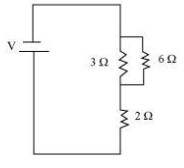
Here,6Ω and 3Ω resistors are connected in parallel.
Therefore, their equivalent resistance will be given by
1/1/6+1/3=2Ω
This equivalent resistor of resistance 2 Ω is connected to a 2 Ω resistor in series.
Therefore, equivalent resistance of the circuit=2Ω+2Ω=4Ω
(b) The following circuit diagram shows the connection of the three resistors.
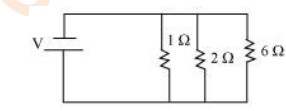
All the resistors are connected in series. Therefore, their equivalent resistance will be given as
1/1/2+1/6+1/3=1Ω
Therefore, the total resistance of the circuit is 1Ω.
Q. What is (a) the highest, (b) the lowest total resistance that can be secured by combinations of four coils of resistance 4 Ω, 8 Ω, 12 Ω, 24 Ω?
Sol. (a)If these coils are connected in series ,then the equivalent resistance will be the highest, given by the sum 4+8+12+24=48Ω
(b)If these coils are connected in parallel, then the equivalent resistance will be the lowest, given by
1/1/4+1/8+1/12+1/24=2Ω
Therefore, 2Ω is the lowest total resistance.
Intext Questions and Solutions Page no. 190
Q. Why does the cord of an electric heater not glow while the heating element does?
Sol. The heating element of an electric heater is a resistor. Heat produced by it is directly proportional to its resistance. The resistance of the element of an electric heater is very high. As current flows through the heating element, it becomes too hot and glows red. On the other hand, the resistance of the cord is low. It does not become red when current flows through it.
Q. Compute the heat generated while transferring 96000 coulomb of charge in one hour through a potential difference of 50 V.
Sol. The amount of heat(H) produced is given by the Joule’s law of heating as
H=VIt
Voltage, V=50V
Time ,t=1h=1×60×60s
Amount of current, I=96000/1×60×60=80/3A
H=50×80/3×60×60
H=4.8×10(6)J
Therefore, the heat generated is 4.8×10(6)J.
Q. An electric iron of resistance 20 Ω takes a current of 5 A. Calculate the heat developed in 30 s.
Sol. The amount of heat(H) produced is given by the joule’s law of heating as
H=VIt
where,
Current, I=5 A
Time, t=30 s
Voltage, V=Current×Resistance=5×20=100 V
H=100×5×30
H=1.5×10(4)J
Therefore, the amount of heat developed in the electric iron is 1.5×10(4)J.
Intext Questions and Solutions Page no. 192
Q. What determines the rate at which energy is delivered by a current?
Sol. The rate of consumption of electric energy in an electric appliance is called electric power. Hence, the rate at which energy is delivered by a current is the power of the appliance.
Q. An electric motor takes 5 A from a 220 V line. Determine the power of the motor and the energy consumed in 2 h.
Sol. Power(P) is:
P=VI
where,
Voltage, V=220 V
Current, I=5 A
P=220×5
P=1100W
Energy consumed by the motor=Pt
where,
Time, t=2 h=2×60×60=7200 s
∴P=1100×7200=7.92×10(6)J
Therefore, power of the motor=1100W
Energy consumed by the motor=7.92×10(6)J
NCERT Class 10 Science Chapter 11 Exercise Questions
Q. A piece of wire of resistance R is cut into five equal parts. These parts are then connected in parallel. If the equivalent resistance of this combination is R′, then the ratio R/R′ is –
(a) 1/25 (b) 1/5 (c) 5 (d) 25
Sol. (d) 25
Explanation: Resistance of a piece of wire is proportional to its length. A piece of wire has a resistance R. The wire is cut into five equal parts.
Therefore, resistance of each part=R/5
All the five parts are connected in parallel.
Hence, equivalent resistance (R') is:
1/R'=5/R+5/R+5/R+5/R+5/R
1/R'=25/R
R/R'=25
Therefore, the ratio is 25.
Q. Which of the following terms does not represent electrical power in a circuit?
(a) I 2R (b) IR2 (c) VI (d) V 2/R
Sol. (b)IR2
Explanation: Electrical power is given by:
P=VI ...(i)
According to Ohm's Law, V=IR ...(ii)
V=Potential difference
I=Current
R=Resistance
P=VI
Now, from equation (i)
P=(IR)×I
P=I2R
From equation (ii)
I=V/R
P=V×V/R
P=V2/R
P=VI=V2/R=I2R
Q. An electric bulb is rated 220 V and 100 W. When it is operated on 110 V, the power consumed will be –
(a) 100 W (b) 75 W (c) 50 W (d) 25 W
Sol. (d)25 W
Explanation: Energy consumed by an appliance is given by the expression,
P=VI=V2/R
R=V2/P
where,
Power rating, P=100 W
Voltage, V=220 V
Resistance, R=220(2)/100=484Ω
The resistance of the bulb remains constant if the supply voltage is reduced to 110 V.
If the bulb is operated on 110 V, then the energy consumed by it is given by the expression for power as
P'=(V')2/R=110(2)/484=25 W
Therefore, the power consumed will be 25 W.
Q. Two conducting wires of the same material and of equal lengths and equal diameters are first connected in series and then parallel in a circuit across the same potential difference. The ratio of heat produced in series and parallel combinations would be –
(a) 1:2 (b) 2:1 (c) 1:4 (d) 4:1
Sol. (c ) 1:4
Q. How is a voltmeter connected in the circuit to measure the potential difference between two points?
Sol. To measure the potential difference between two points, a voltmeter should be connected in parallel to the points.
Q. A copper wire has diameter 0.5 mm and resistivity of 1.6 × 10–8 Ω m. What will be the length of this wire to make its resistance 10 Ω? How much does the resistance change if the diameter is doubled?
Sol. Resistance (R) of a copper wire of length l and cross-section A is:
R=pl/A
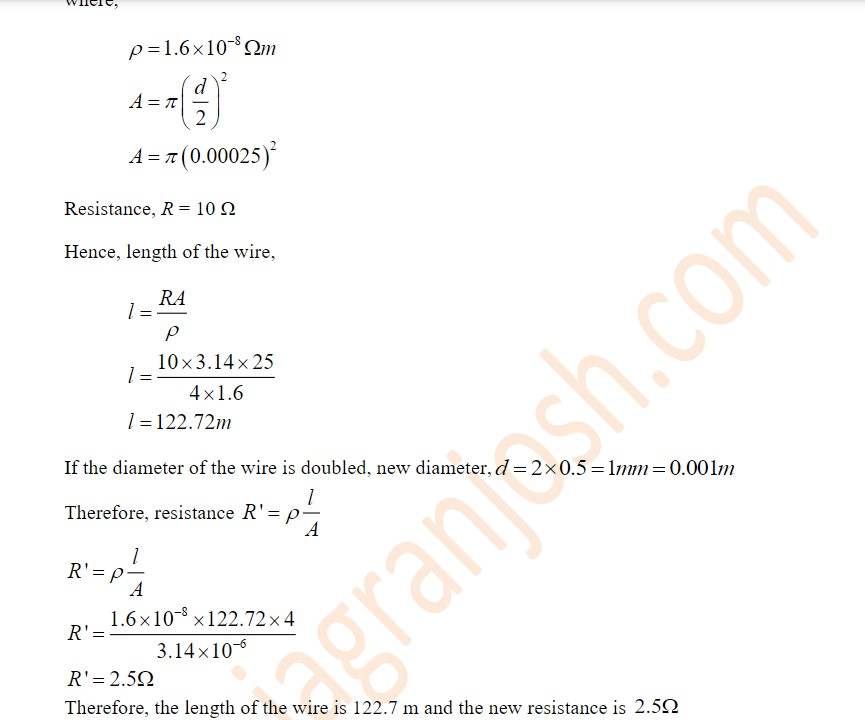
Q. The values of current I flowing in a given resistor for the corresponding values of potential difference V across the resistor are given below –
I (amperes) 0.5 1.0 2.0 3.0 4.0
V (volts) 1.6 3.4 6.7 10.2 13.2
Plot a graph between V and I and calculate the resistance of that resistor.
Sol. The plot between voltage and current is called IV characteristic. The voltage is plotted on x-axis and current is plotted on y-axis. The values of the current for different values of the voltage are shown in the given table.
V 1.6 3.4 6.7 10.2 13.2
I 0.5 1.0 2.0 3.0 4.0
The IV characteristic of the given resistor is plotted in the following figure.
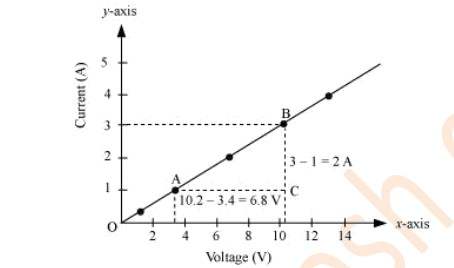
The slope of the line gives the value of resistance(R)
Slope=1/R=BC/AC=2/6.8
R=6.8/2=3.4Ω
Therefore, the resistance of the resistor is 3.4Ω.
Q. When a 12 V battery is connected across an unknown resistor, there is a current of 2.5 mA in the circuit. Find the value of the resistance of the resistor.
Sol. Resistance (R) of a resistor is given by Ohm's law as,
V=IR
R=V/I
where,
Potential difference, V=12 V
Current in the circuit , I=2.5 mA=2.5×10-3A
R=12/2.5×10-3
R=4.8kΩ
Q. A battery of 9 V is connected in series with resistors of 0.2 Ω, 0.3 Ω, 0.4 Ω , 0.5 Ω and 12 Ω, respectively. How much current would flow through the 12 Ω resistor?
Sol. There is no current division occurring in a series circuit. Current flow through the component is the same, given by Ohm’s law as
V=IR
R=V/I
where,
R is the equivalent resistance
R=0.2+0.3+0.4+0.5+12=13.4Ω
Potential difference, V=9 V
I=9/13.4=0.671A
Therefore, the current that would flow through the 12Ω resistor is 0.671A.
Q. How many 176 Ω resistors (in parallel) are required to carry 5 A on a 220 V line?
Sol. For x number of resistors of resistance 176Ω, the equivalent resistance of the resistors connected in parallel is given by Ohm’s law as
V=IR
R=V/I
where,
Supply voltage, V=220V
Current, I=5A
Equivalent resistance of the combination=R,
1/R=x×1/176
R=176/x
From Ohm's law,
V/I=176/x
x=176×5/220
x=4
Therefore, four resistors of 176Ω are required to draw the given amount of current.
Q. Show how you would connect three resistors, each of resistance 6 Ω, so that the combination has a resistance of (i) 9 Ω, (ii) 4 Ω.
Sol. If we connect the resistors in series, then the equivalent resistance will be the sum of the resistors,i.e.,6Ω+6Ω+6Ω=18Ω, which is not desired. If we connect the resistors in parallel, then the equivalent resistance will be 3Ω
Hence, we should either connect the two resistors in series or parallel.
(i)Two resistors in parallel
Two 6Ω resistors are connected in parallel. Their equivalent resistance will be
1/1/6+1/6=3Ω
The third 6Ω resistor is in series with 3Ω. Hence, the equivalent resistance of the circuit is 6Ω+3Ω=9Ω.
(ii)Two resistors in series
Two 6Ω resistors are in series. Their equivalent resistance will be the sum 6+6=12Ω
The third 6Ω resistor is in parallel with 12Ω. Hence, equivalent resistance will be
1/1/12+1/6=4Ω
Therefore, the total resistance is 4Ω.
Q. Several electric bulbs designed to be used on a 220 V electric supply line, are rated 10 W. How many lamps can be connected in parallel with each other across the two wires of 220 V line if the maximum allowable current is 5 A?
Sol. Resistance R1 of the bulb is:
P1=V2/R1
R1=V2/P1
where,
Supply voltage, V=220 V
Maximum allowable current, I=5A
P1=10W
R1=220(2)/10=4840Ω
As per Ohm's law,
V=IR
where,
R is the total resistance of the circuit for x number of electric bulbs
R=V/I=220/5=44Ω
Resistance of each electric bulb=4840Ω
1/R=1/R1+1/R1+1/R1+..........x times
1/R=1/R1 x
x=R1/R=4840/44=110
Therefore, 110 electric bulbs are connected in parallel.
Q. A hot plate of an electric oven connected to a 220 V line has two resistance coils A and B, each of 24 resistance, which may be used separately, in series, or in parallel. What are the currents in the three cases?
Sol. (i)When the two coils A and B are used separately.
I = V/R
I=220V/24Ω=9.166 A
(ii)When the two coils are connected in series.
The total resistance in the series circuit is 24 Ω + 24 Ω = 48 Ω
The current flowing through the series circuit is calculated:
I=V/R=220V/48Ω=4.58A
(iii)When the two coils are connected in parallel.
When the coils are connected in parallel, the equivalent resistance is calculated as:
R=24×24/24+24=576/48=12Ω
Using Ohm's law,
I=V/R=220/12=18.33A
Q. Compare the power used in the 2 Ω resistor in each of the following circuits: (i) a 6 V battery in series with 1 Ω and 2 Ω resistors, and (ii) a 4 V battery in parallel with 12 Ω and 2 Ω resistors.
Sol. (i) The current in the circuit can be calculated using the Ohm’s law as:
I=V/R=6/3=2A
Power in 2Ω resistor can be calculated:
P=I2R=(2)2×2=8W
Therefore, the power consumed by the 2 Ω is 8 W.
(ii)Power consumed by the resistor is calculated as:
P=V2/R=4(2)/2=8W
The power consumed by the 2 Ω resistor is 8 W.
Q. Two lamps, one rated 100 W at 220 V, and the other 60 W at 220 V, are connected in parallel to electric mains supply. What current is drawn from the line if the supply voltage is 220 V?
Sol. Both the bulbs are connected in parallel. Therefore, potential difference across each of them will be 220V, because no division of voltage occurs in a parallel circuit.
Current drawn by the bulb of rating 100 W is given by,
P=V×I
I=P/V=100/220A
Similarly, current drawn by the bulb of rating 60W is given by,
I=P/V=60/220A
The current drawn from the line is:
100/220+60/220=0.727A
Q. Which uses more energy, a 250 W TV set in 1 hr, or a 1200 W toaster in 10 minutes?
Sol. Energy consumed by an electrical appliance is given by the expression,
H=Pt
where,
Power of the appliance=P
Time=t
Energy consumed by a TV set of power 250 Win 1 h=250×3600=9×10(5) J
Energy consumed by a toaster of power 1200 W in 10 minutes=1200×600=7.2×10(5)J
Q. An electric heater of resistance 44 Ω draws 5 A from the service mains for 2 hours. Calculate the rate at which heat is developed in the heater.
Sol. P=I2R
where,
I is current
R is resistance
P=(5A)2×44Ω=25×44=1100 W
Rate at which heat is developed in the heater is 1100 watts.
Q. Explain the following.
(a) Why is the tungsten used almost exclusively for filament of electric lamps?
(b) Why are the conductors of electric heating devices, such as bread-toasters and electric irons, made of an alloy rather than a pure metal?
(c) Why is the series arrangement not used for domestic circuits?
(d) How does the resistance of a wire vary with its area of cross-section?
(e) Why are copper and aluminium wires usually employed for electricity transmission?
Sol. (a)The melting point and resistivity of tungsten are very high. It does not burn easily at high temperature. The electric lamps glow at very high temperatures. Thus, tungsten is mainly used as heating element of electric bulbs.
(b)Because resistivity of an alloy is more than that of metals. It produces large amount of heat.
(c )There is voltage division in series circuits. Each component of a series circuit receives a small voltage for a large supply voltage. As a result, the amount of current decreases and the device becomes hot. Hence, series arrangement is not used in domestic circuits.
(d)Resistance of a wire is inversely proportional to its area of cross-section i.e., thinner the wire the more will be its resistance and vice versa.
(e)Copper and aluminium wires have low resistivity. They are good conductors of electricity. Hence, they are usually employed for electricity transmission.
To download these solutions in pdf, refer to the below link:
| Download NCERT Class 10 Science Chapter 11 Electricity Solutions PDF |
CBSE Video Courses for Class 10 Students
Class 10 students can study effectively for the exams with the help of video courses prepared by the subject matter experts. These video courses will explain the concepts in a simple and interactive manner which will help learners to understand clearly.
Also, check
CBSE Class 10 Science Lab Manual PDF
CBSE Class 10 Science syllabus 2024-25
Archimedes' Principle: Formula, Derivation, Applications and Examples
Comments
All Comments (0)
Join the conversation